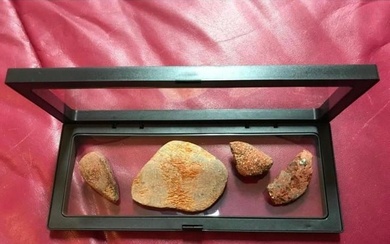Prehistoric 30 Million Year Old Fossil Horse Teeth
Prehistoric fossil teeth, display specimen. Type: Mesohippus bairdi, Early Three Toed Horse fossil lower tooth. Locality: Private land in Pennington County, South Dakota Age: Oligocene, 30 Million Years Ago Equidae, Primitive horses, Mesohippus and their relatives. Of all the fossils found in the White River Badlands, those of equids or horse-like mammals remain among the most popular. Because of the wealth of material available from numerous fossil beds in North America that span multiple epochs, major changes in equid skull and foot morphology became the basis for a long-held model of gradual evolution that was depicted in countless early books on paleontology. Since 1972, however, modern paleontologists view the evolution of equids as one of the best examples of "punctuated equilibrium". In this theory, the morphology of sexually reproducing animals changes little over time until environmental factors cause them to change rapidly over a short period of time. This striking change from the small earliest equids less than a foot tall, to the large, present day equids of Africa and Asia is arguably one of the best examples of punctuated equilibrium known. For equids in North America, punctuated equilibrium is based upon the understanding of a complete series of high quality fossils spanning a virtually unbroken lineage over at least 55 million years. Equids found in the White River Badlands represent the early to middle stages of equid evolution.
[ translate ]View it on
Estimate
Time, Location
Auction House
Prehistoric fossil teeth, display specimen. Type: Mesohippus bairdi, Early Three Toed Horse fossil lower tooth. Locality: Private land in Pennington County, South Dakota Age: Oligocene, 30 Million Years Ago Equidae, Primitive horses, Mesohippus and their relatives. Of all the fossils found in the White River Badlands, those of equids or horse-like mammals remain among the most popular. Because of the wealth of material available from numerous fossil beds in North America that span multiple epochs, major changes in equid skull and foot morphology became the basis for a long-held model of gradual evolution that was depicted in countless early books on paleontology. Since 1972, however, modern paleontologists view the evolution of equids as one of the best examples of "punctuated equilibrium". In this theory, the morphology of sexually reproducing animals changes little over time until environmental factors cause them to change rapidly over a short period of time. This striking change from the small earliest equids less than a foot tall, to the large, present day equids of Africa and Asia is arguably one of the best examples of punctuated equilibrium known. For equids in North America, punctuated equilibrium is based upon the understanding of a complete series of high quality fossils spanning a virtually unbroken lineage over at least 55 million years. Equids found in the White River Badlands represent the early to middle stages of equid evolution.
[ translate ]



